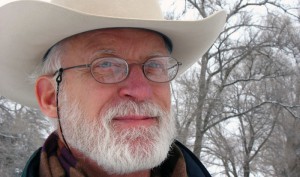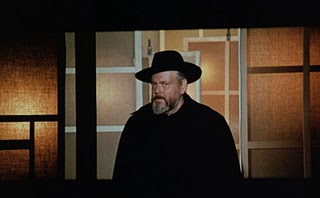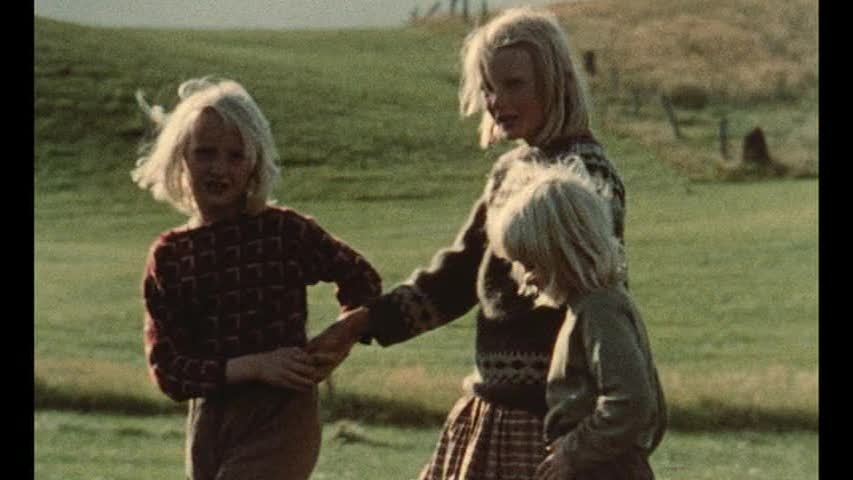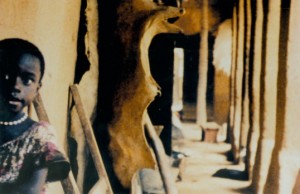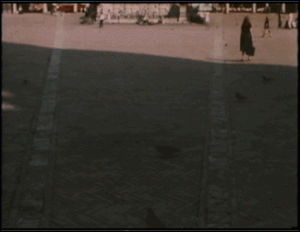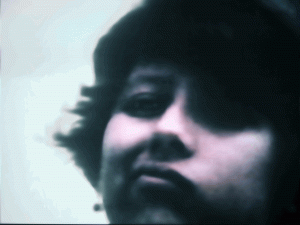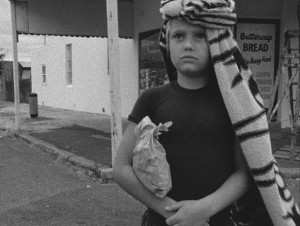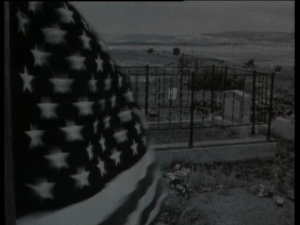From the Chicago Reader (August 26, 1988). — J.R.
UNCOMMON SENSES
Directed and written by Jon Jost.
The film essay, as opposed to the documentary, remains in some respects the most neglected of contemporary film genres, by filmmakers and audiences alike, perhaps because it is seldom acknowledged as a film form at all. The only recent mainstream examples that come to mind are the first two parts of Godfrey Reggio’s trilogy, Koyaanisqatsi (1983) and Powaqqatsi (1988). As an English reviewer remarked of Koyaanisqatsi — a film that, incidentally, owed most of its exposure to Francis Ford Coppola’s distribution — “Its vainglorious appeal as a ‘new cinematic experience’ is really to an audience that would rather be open-mouthed than open-minded.” I found its glib borrowings from the avant-garde so irritating that I had no sense of regret about missing its sequel.
On the other hand, the most masterful examples I can think of from the last two decades — Orson Welles’s F for Fake (1973) and Chris Marker’s Sans soleil (1982) — both flopped commercially in this country. And most of the other distinguished examples from the 70s and 80s seem to appear only on the experimental film circuits: Trinh T. Min-ha’s Reassemblage (1982) and Naked Spaces (1985), Chicago filmmaker Peter Thompson’s Universal Hotel/Universal Citizen (1986-87; available on tape at Facets), Jane Campion’s 1984 Passionless Moments (which showed at the Film Center last weekend), and Jon Jost’s Speaking Directly: Some American Notes (1973; also available on tape at Facets).
Uncommon Senses, a kind of sequel to Speaking Directly, might be called Jost’s second feature-length State of the Union essay, made 15 years later. Like its predecessor, it is composed of several different and relatively autonomous sections, each of which has its own form and mode of address. While both films can be described as didactic, the first is overtly autobiographical, the second more a multifaceted statement about America. Subtitled Plain Talk & Common Sense, Uncommon Senses is Jost’s eighth feature to date, and it can be regarded in some respects as a summation of his previous efforts — a varied, durable body of independent work that, despite its limited exposure, has tended to grow in resonance and power over the years. At the same time, like each of the preceding features, Uncommon Senses can be seen as a fresh effort, a departure. (Jost’s ninth feature, Rembrandt Laughing, was completed earlier this summer.)
Composed of a prologue, ten sections, and a postscript, Uncommon Senses confronts head-on the notion of multiplicity (which all ambitious writers about this country have seemed to rely on — from Walt Whitman to Carl Sandburg to John Dos Passos to Thomas Wolfe to Jack Kerouac and beyond). The rapturous catalog is its organizing principle. The endlessly burgeoning list — with counterparts in everything from the Bible to the Sears Roebuck catalog to almanacs and telephone directories as well as in such writers as Herman Melville, Allen Ginsberg, and Thomas Pynchon — has always had its seductive and contagious side; this sentence shows its influence. But few artists in this country have ever tried to analyze or critique this list-making habit as a rhetorical and ideological impediment, a mode of discourse that conceals and mystifies in the process of showing us “everything.” Part of the originality and importance of Jost’s new film is that it proceeds to do just that — to critique list making even as it employs it.
Jost seemingly arrived at this critique by default rather than by design. He has driven across this country and back more times than any other filmmaker I know, typically taking back roads rather than interstates; and when he received a sum of money from English television to make a low-budget feature essay about present-day America, he made another extended and extensive cross-country trip, shooting footage as he went. Yet when he returned from his travels, he found that, by conventional filmmaking standards, he had shot practically nothing at all — a total of two hours or less. The implications of this and the reasons for it are an implicit part of what the film explores. Jost’s unusual rigor and frugality in all of his work obviously accounts for some of it; his shooting ratios are considerably lower than those of most other filmmakers. But in this case, he had the resources to shoot a great deal if he wanted to, and the fact that he didn’t clearly stemmed from the evolving essayistic, rather than documentary, thrust and content of the film.
Jost first evokes America as a “place,” a “thing,” a “sound,” a “presence,” and a “power” in his offscreen narration — while focusing on a shot of a lovely field that dissolves slowly into closer shots of dark grass, moving water, and a large hand appearing in double-exposure over the water. He then moves on to part one of the film, “Four Corners.” He plants his camera at a roadside tourist spot where New Mexico, Arizona, Colorado, and Utah meet, and records from several passing tourists their fascination with this place, meanwhile ruminating briefly on a theme that will gradually come to dominate the film: the attraction exerted by such spots in the United States. They represent “that something which we would like to get our grips on” — an emblem of the elusiveness of the country itself.
Section two, “Coasts,” attacks that elusiveness in a more conceptual manner — it virtually parodies the Whitmanesque impulse to contain multitudes, to reach for all-inclusiveness. Over 340 years of American history and the entire geographical expanse of the country are encapsulated in a matter of a few minutes. On the sound track, overlapping voices recite portions of texts, beginning with the 1620 Mayflower Compact and ending with Allen Ginsberg’s 1961 poem Kaddish, encompassing over 100 chronologically ordered quotations in all. What we see are beautiful overlapping NASA satellite photographs of the American mainland, proceeding sequentially from the east to the west — photographs taken in black and white and then luminously colorized by computer for scientific reasons.
Part three, “Crosscurrents,” takes up the multiplicity of “received images” of America, literally as well as figuratively, by running through a partially pixilated inventory of postcards and similar American iconic images (both still and in motion). These images appear in various ways: several appear on the screen at once or in succession; the images themselves range from toy tanks moving over dollar bills to Mount Rushmore to apple pie a la mode being eaten in fast motion. Meanwhile Jost’s offscreen narration contrapuntally discusses the range and nature of this imagery. (In more ways than one, this is the sequence that shows Jost’s technical and conceptual virtuosity at its most impressive; it would be impossible to paraphrase all he does here without creating an endless catalog of one’s own.)
Sometimes as many as 16 moving or still frames appear on the screen at once, but the commentary gradually moves from emulating this profusion to questioning it: “To go on in such a way would be only to emulate, to demonstrate by copying, and finally to succumb to the very thing we are trying to see clearly. No, the simple truth is that to pile on more and more will only obscure and confuse–and perhaps do exactly what this system, whether consciously or not, is designed to do: to hide itself, its little inner workings and aims, by dipping behind a vast array of surfaces.” Eventually the images are reduced to a single promotional film short for a city in Colorado; it occupies most of the screen, narrated by a woman’s voice that supplants Jost’s.
Part four, “Inside/Outside,” focuses on Rockwell International’s management of nuclear facilities in Colorado and Washington, moving through more promotional material as well as a few bald facts to offset it — such as the fact that Rockwell did over $12 billion in business in 1986, almost double the figure for 1982. Part five, “Songs,” mainly juxtaposes a poem in the beat style (written by Jost) with a shot taken from a moving car driving past an endless military installation, and part six, “Numbers,” gives us a skeptical mini-essay on the use and nature of statistics while treating us to a visual onslaught of statistical data about Americans. This data crosses the screen both forward (in yellow letters) and backward (in red), along with an equally horizontal procession of nude figures taken from Eadweard Muybridge’s 19th-century motion studies.
As in the overlapping voices and images of “Coasts,” Jost is orchestrating densely interwoven tapestries and mosaics not to convey information, but to convey the problems in understanding that derive from too many facts about some things (“outside”) and too few about others (“inside”). In part seven, “Americans,” he returns to the simpler and more direct documentary manner of “Four Corners” — this time without any offscreen narration — by inviting a series of people to introduce themselves to the camera however they see fit. Standing against a black background, each is allotted about 30 seconds.
Parts one and seven, “Four Corners” and “Americans,” are in some ways even more challenging and difficult than all five of the intervening sections because of the relative freedom that they offer the spectator in processing what is shown. In contrast to the factual overloads and absences of the other parts, the question of what constitutes a fact or adds up to information about these people is much more open and ambiguous. The temptation of some spectators to snicker at these people or feel that Jost is somehow exploiting them is in a way a displacement of their own discomfort in not knowing how to respond. The didacticism of sections two through six may be hard to cope with in spots, but the absence of didacticism here puts us completely at sea. Much of the subtlety and brilliance of the structure of Uncommon Senses has to do with its diverse and ingenious strategies for deprogramming our responses, alternately giving us “too much” and “too little” in order to confront us with the kinds of rhetorical structures that we tend to encounter unthinkingly elsewhere.
Part eight, “America,” returns us to the conceptual didacticism of “Coasts” by giving us another carefully controlled history lesson, this time through animated maps, accompanied by original music by John A. English that reflects some Native American influence. Here the history covers about 500 years in five minutes, with red dots denoting Indian settlements and white dots standing for whites. The focus is mainly ecological — the withdrawal of forests, the beginning of farmland and irrigation, and eventually the construction of military installations. But it must be admitted that here the absence of narration creates a problem — what I know about this sequence comes from a conversation with Jost, and without his tips, I doubt that many spectators will have much of an idea about what they’re seeing.
Part nine, “Heart of the Country,” shows us first the demographic center of America, “in the farmlands a little southwest of Saint Louis, not far from the Mississippi,” and then the geographic center, “a bit north of Belle Fourche, South Dakota, hard by the Wyoming border — the center of a hypothetical geographic plane which includes all of the mainland, Alaska, and Hawaii.” The geographic center proves to be the same lovely field that we glimpsed in the prologue.
“Here is another place,” says Jost offscreen, “like the quadrant of Four Corners, designated by the happenstance of politics and geometry, to symbolize, to represent, to stand, it seems, for some ineffable something: somehow, here, at the ‘center of the nation’ one anticipates a revelation, that the metaphysic of nationhood would stand stripped, turn physical, palpable, something one could get one’s hands on.”
No such luck: there’s only sky, plains, and wind, which the camera gracefully traverses until we gradually turn upside down. But ironically, we hear, this spot, lies within the boundaries of Ellsworth Air Force Base, whose missile fields extend for hundreds of miles around; buried directly beneath this placid setting are Minuteman missiles armed with nuclear warheads. And the “heart of the country,” Jost concludes, lies in neither places nor symbols, but in ourselves and what we choose to do.
This leads to part ten, “The Bottom Line,” a lecture about the income tax delivered by a man dressed in judge’s robes, with emphasis given to the fact that a citizen does not have a right to know what happens to his or her tax money. And this is followed in turn by a postscript lecture by Jost himself that denounces the “Nation/State,” specifically the inner workings of this country and the evils it perpetrates.
The two concluding lectures, one should note, were both written by Jost, and however reductive and prosaic they may seem in relation to what has gone before, the film’s overall structure and cumulative drift might be said to make them inevitable. At the same time, whether or not this coincides with Jost’s own aims, I think it would be shortchanging the overall richness of the film to interpret it exclusively as a linear argument. The materials set before us can be mentally juggled and synthesized other ways as well, and each of the sequences can be regarded as starting points for an analysis as well as consecutive building blocks. The argument in “Heart of the Country,” for example, that what we call “America” tends to be hidden rather than visible, although it certainly applies to nuclear warheads, also applies to poverty, racism, sexism, and a great deal more.
In his first feature, Speaking Directly, Jost essentially began with himself and his own life — including his two years in federal prison for draft resistance in the mid-60s, and the conditions of his career as a low-budget filmmaker — and eventually expanded to a detailed political critique of the United States in the early 70s (and incidentally one of the best political analyses of that period on film that we have). In Uncommon Senses, Jost has in some respects inverted that process, beginning with a general critique and then working his way toward its more personal implications, winding up with his own solitary figure. In the 70s, the targets of his critique were a good deal more visible, both to himself and to the public. Today they are harder to get at, and require new modes of perception — reflection about not only how this country is constituted, but how our understanding of it is constructed. For anyone who cares about such matters, Uncommon Senses is an uncommon and invaluable act of clarity, and, better yet, a tool.

